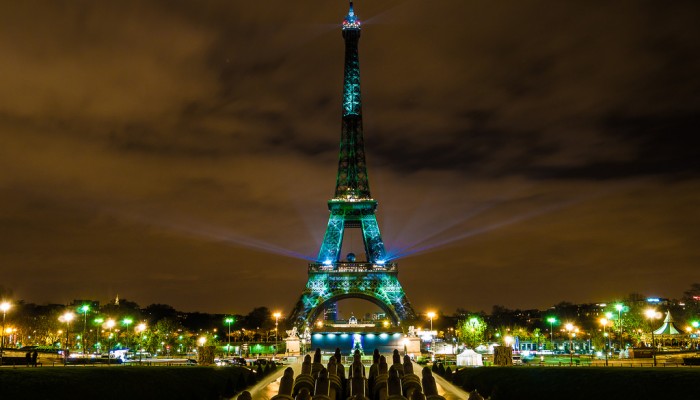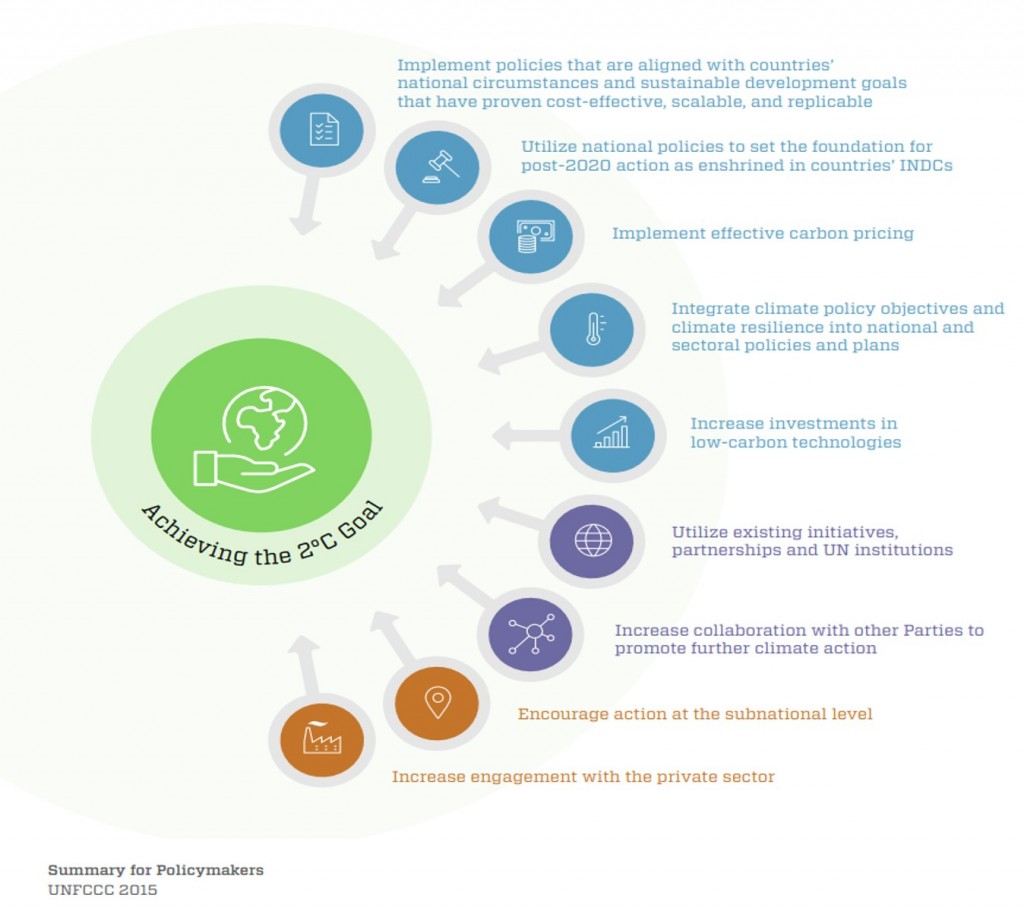
Last week saw the world’s leaders come together in Paris for the 21st ‘Conference of the Parties’ (aka COP21) to discuss climate change. The 12 day meeting saw over 50,000 participants (half of which from Government organisations) come to reach an agreement on limiting greenhouse gas (GHG) production.
Background
Manmade climate change, resulting from the increased production of GHG into the atmosphere, has caused the Earth to warm by over 1 °C since pre-industrial times. If global emissions continue to rise at this rate the world will be roughly 5 °C warmer by 2100 (that’s the same difference in temperature between now and the last ice age). A temperature change of that range will have major impacts on the Earth and its inhabitants. For decades, world leaders have met to discuss strategies for reducing GHG emissions. The 2009 COP aimed to limit global warming to 2 °C; a level considered to be preventing “dangerous anthropogenic interference with the climate system” [1]. However, there has been no legally binding treaties to come from a COP where all countries were in agreement. A legislative agreement was the major goal for COP21.
The video below gives a good summary of the COP history including which meetings were considered successes and which were failures.
COP21 primer: A brief history of climate talks
What did the EU countries pledge?
Before COP21, countries submitted ‘Intended Nationally Determined Contributions’, or INDCs, which laid out their individual plans for GHG reduction.
As a whole, the EU submitted relatively aggressive INDCs, pledging a reduction of GHGs of at least 60 % below 2010 levels by 2050. This pledge would be legally binding if all parties agree. The EU already has legislation that requires all 28 member states to reduce their emissions by at least 40 % by 2030, compared to 1990 [2].
The UNFCCC ‘Climate Action Now’ briefing
The United Nations Framework Convention for Climate Change (UNFCCC) is the organisation who organises the COPs. After all the INDCs were submitted but before the meeting they published their ‘Climate Action Now’ briefing which summarised the pledges so far and the major policy routes to be taken to achieve only a 2 °C warming. I summarised this document into a storify of tweets but the major highlights are listed below:
- Current INDC pledges do not limit global warming to 2 °C but to 3.7-4.8 °C
- 2 °C limit can still be reached through suggested policy solutions but ‘Achieving the 2 degree goal requires immediate action and the full engagement of Parties and other relevant stakeholders’
- Targeted financial support, tech transfer and capacity-building (especially for developing countries) is needed.
- There are multiple co-benefits to climate mitigation policies which include water and food security, biodiversity improvements, economic benefits, improved health, and higher air quality.
- 6 policy themes are: Renewables, Energy Efficiency, Transport, Carbon Capture, Non-CO2 GHGs, Land use, Adaptation co-benefits.

Policy Summaries from the UNFCCC Climate Action Now Report. Credit: UNFCCC (distributed via ClimateAction2020)
Highlights from the meeting
- Drafting the agreement throughout the meeting and getting the new treaty signed was the primary goal of COP21. A consensus had to be met from all 196 participating countries to make a legally binding document. The draft agreement went through three rounds of edits over the 2 week meeting. It started being 48 pages in length which was reduced to 28 pages, then 27, but finally ending up at 31 pages. Prior draft agreements highlighted any contentious issues in square brackets. The first draft had a staggering 939 areas of disagreement. This was reduced to 367, and then to 50 in the final draft published on December 11th.
- Day 1 of the meeting saw 150 of the world leaders come together to give key speeches and highlight their Nation’s pledges. President Obama spoke of the need for a “flow to the countries that need help preparing for the impacts of climate change we can no longer avoid”. China’s President, Xi Jinping, spoke of his country’s aim to peak GHG emission by 2030. Other new initiatives were announced including the Solar Alliance, which aims to “foster cooperation and collaboration between solar-rich nations”. New Zealand’s Prime Minister spoke of the need to reduce fossil fuel subsidies and to allow these funds to be invested in low-carbon technology. [More information on Day 1’s highlights can be found on the Carbon Brief Website] [3].
- 1.5 or 2 degrees warming was a hotly debated topic throughout the meeting. It was put forward at the beginning of COP21 by the Climate Vulnerable Forum, which consists of 20 developing countries. 100% renewable energy and full decarbonisation by 2050 was also called for by this forum. Before the meeting the 2 degree limit was discussed more often, but surpassing a 1.5 degree rise could still be damaging, as Dr Rachel Warren, a from the University of East Anglia, told the Carbon Brief: “In the 5th assessment of the IPCC (2013), when we assessed the reasons for concern about climate change and we considered unique and threatened systems, we found that a transition from moderate to high risk to those systems occurred somewhere between 1.1-1.6 °C above pre-industrial, whereas by 2 °C the risks to those systems were already high.” Article 2 was heatedly debated but the final wording of the treaty became “Hold the increase in the global average temperature to well below 2 °C above pre-industrial levels and to pursue efforts to limit the temperature increase to 1.5 °C” [4].
- The long term goal has been included in the agreement to account for the current pledges falling short of the 2 degree limit. This was another debated issue throughout COP21. The resulting text reads that “a balance between anthropogenic emissions by sources and removals by sinks of GHGs in the second half of this century”. This is a compromised statement compared to previous drafts which offered either specific dates for these goals to be achieved or used the more vague term of achieving “emissions neutrality”. The term ‘balance’ has also been criticised as being too ambiguous. Additionally, the final text offers the opportunity for carbon capture techniques to be used to achieve net zero emissions [5].
- A five year review cycle features in the agreement where countries must continue to make pledges, similar to the INDCs, that demonstrate how they plan to further reduce their emissions. This section was included to account for the gap in countries’ pledges and the desired 2 degree warming limit. These meetings will commence in 2020 (when the agreement legally comes into being).
- Financial aid from developed countries to support developing states with renewable energy projects is described as a legal requirement in the agreement. In previous drafts this included a quantified amount of at least $100 billion per year, however this value is now in a flexible / voluntary section of the agreement. A new ‘Loss and Damage’ term legally requires developed countries to offer financial aid to ‘small islands and vulnerable states’ to help them tackle inevitable effects of climate change these nations are/will experience. However, liability and compensation terms have been explicitly left out of the agreement. For a full list of the current funding pledges please see the UNFCCC’s Climate Funding Announcements webpage. [6].
‘Not perfect’
The agreement has been described by many as ‘not perfect’. Some phrases have been criticised as too vague and not all terms are legally binding, for example, a voluntary emissions trading scheme is described. Willing countries can sign up but there must be at least 55 parties, covering at least 55% of global emissions for the scheme to be adopted.
Future implications
President Obama stated that the Paris agreement is “the best chance we have to save the one planet we have”. China’s chief negotiator Xie Zhenhua also stated that, although the agreement is not ideal, “this does not prevent us from marching historical steps forward” [7]. The positivity and optimism from the first day of COP21 has remained throughout the whole meeting. Now, countries must adhere to their pledges to decrease GHG emissions if we are to limit global climate change to a 2 degree warming.
—
You can read the signed treaty on the UNFCCC’s website.
Sources
[2] – EP At a glance plenary 12 October 2015 ‘EU approach to the Paris climate conference’
[3] – http://www.carbonbrief.org/analysis-the-key-announcements-from-day-1-at-cop21
[4] – http://www.carbonbrief.org/scientists-discuss-the-1-5c-limit-to-global-temperature-rise
[5] – http://www.carbonbrief.org/explainer-the-long-term-goal-of-the-paris-climate-deal
[6] – http://www.carbonbrief.org/analysis-the-final-paris-climate-deal
[7] – http://www.bbc.co.uk/news/science-environment-35086346




Pingback: Cryospheric Sciences | Image of the Week – Climate Change and the Cryosphere
Pingback: GeoLog | GeoPolicy: What will a Trump presidency mean for climate change?
Pingback: Geology for Global Development | Reviewing Key Agreements of 2015
Pingback: GeoLog | GeoPolicy: What was decided from the Paris COP21? | Ukko Elhob's World